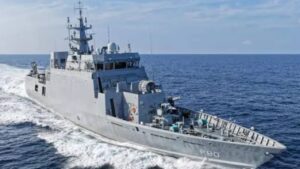Digital News Guru National Desk:
Indian Navy’s new Mahe-class ASW vessel commissioning
The Indian Navy is poised to mark a significant milestone on 24 November 2025, with the commissioning of INS Mahe, the first vessel of the Mahe-class Anti-Submarine Warfare Shallow Water Craft (ASW-SWC). The induction ceremony will take place at the Naval Dockyard in Mumbai, signaling a major leap in India’s indigenous shipbuilding and coastal defense capabilities.
Indigenous Design & Construction
INS Mahe has been built by Cochin Shipyard Limited (CSL) in Kochi — one of India’s premier shipbuilding facilities. The vessel is the first of a planned eight Mahe-class ASW-SWC ships, reflecting India’s push toward self-reliance in naval capabilities.

Remarkably, over 90% of the ship’s components are sourced from Indian manufacturers, underscoring the strength of the domestic defense manufacturing ecosystem. This is very much in line with the government’s Aatmanirbhar Bharat (self-reliant India) initiative.
Technical Capability & Role
INS Mahe is about 78 meters long and displaces approximately 1,100 tonnes. One of its standout features is its diesel engine + waterjet propulsion system, which gives it excellent maneuverability and a lower acoustic signature — critical for anti-submarine warfare.
Strategically, Mahe is designed for multiple roles:
- Sub-surface defense: detecting and engaging submarines in shallower coastal or littoral waters
- Underwater surveillance: using sonar and other sensors to monitor underwater activity
- Mine-laying: an ability to deploy naval mines, adding to its versatility in maritime operations
- Search & Rescue (SAR): undertaking missions in times of maritime distress
- Low-Intensity Maritime Operations (LIMO): operating in scenarios that require smaller, agile warships rather than large destroyers or frigates.
Strategic Significance
- Enhanced Coastal Defense: With Mahe and its sister ships, the Navy’s anti-submarine warfare (ASW) capability in shallow coastal waters will get a major boost. Traditional large warships or submarines may struggle in very shallow or constrained maritime zones; shallow-water craft like Mahe are tailor-made for these environments.

- Indigenization: Mahe is a clear manifestation of India’s growing competence in warship design and construction. The high domestic content shows India’s defense industry has matured to deliver advanced systems without heavy reliance on foreign technology.
- Force Modernization: These ASW-SWC vessels are part of a broader plan to replace older corvettes (like the Abhay-class) with modern, stealthier, more capable ships.
- Maritime Security & Deterrence: As submarine threats in the Indian Ocean region grow, especially from near-peer adversaries, the Mahe-class contributes substantially to India’s layered defense architecture.
Timeline & Program Context
- The steel-cutting for the Mahe-class began long ago, and the contract for building eight of these was signed in 2019.
- CSL formally delivered INS Mahe to the Navy on 23 October 2025.
- According to official sources, the delivery and commissioning timeline for the remaining ships in the class extends through 2028.
Comparison With Other ASW-SWC Ships
Earlier in 2025, the Navy had commissioned INS Arnala, another ASW-SWC vessel, but of a different design. Arnala was built by Garden Reach Shipbuilders & Engineers (GRSE) in Kolkata, showing that the Navy is diversifying its shallow-water ASW fleet across different shipyards and designs.
Broader Implications
- Industrial Impact: The Mahe-class project brings work to a wide network of suppliers, including MSMEs, in India’s defense sector. This not only boosts employment but strengthens the defense supply chain.
- Technological Leap: With modern sonar systems and propulsion, these vessels represent a technological upgrade over older anti-submarine platforms. Their design reflects cutting-edge thinking on how to operate in congested littoral waters.

- Strategic Messaging: Commissioning Mahe sends a strong signal internationally — India is not only investing in its navy, but also doing so with indigenous capabilities, reducing reliance on foreign suppliers.
- Future Naval Warfare: As the Indian Ocean region becomes more contested, having a fleet of shallow-water ASW craft gives the Indian Navy an asymmetric advantage. These ships can operate close to the coast, detect and deter submarines, and protect vital maritime trade routes or coastal assets.
Conclusion
The commissioning of INS Mahe on 24 November 2025 is more than just a ship induction — it’s a symbol of India’s growing naval self-reliance, technological maturity, and strategic foresight. As the first of the Mahe-class ASW-SWCs, Mahe will play a critical role in protecting India’s coastal waters from submarine threats, enabling the Navy to maintain a robust, modern, and home-grown fleet.
This development underlines how India is not just building more ships — it is building smarter, locally, and with an eye on future maritime security challenges.
You May Also Read: Tragedy in Kashmir: Accidental Blast at Nowgam Police Station Kills 9, Injures Dozens








